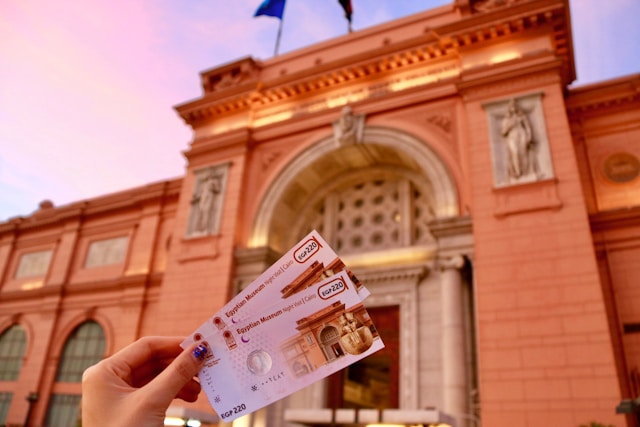Founded in 1857 by the French archaeologist Auguste Mariette, the Egyptian Museum of Cairo was initially intended to house and display the growing collection of artifacts discovered in Egypt during the 19th century. Originally located in the Boulaq district, the museum moved to its current home in Tahrir Square in 1902, in a building designed by the French architect Marcel Dourgnon. Today, it stands just a short distance from major attractions like Cairo Tower and the bustling El Moez Street.
Over the years, the museum has become a symbol of Egypt's cultural heritage, offering an immersive experience into the world of pharaohs, gods, and the timeless civilization that shaped much of human history. As one of the most visited museums globally, it attracts millions of tourists annually who come to witness the awe-inspiring collection of mummies, statues, and ancient relics.
🔹 Recommended Experience: Book a 14 Day Egypt Tour
The Museum’s Iconic Collection: A Glimpse into Ancient Egypt’s Majesty
The King Tutankhamun Gallery: An Ancient Pharaoh's Legacy
The Egyptian Museum’s King Tutankhamun Gallery is perhaps its most famous section. King Tut, the boy king who ascended the throne at a young age, became iconic due to the discovery of his nearly intact tomb by British archaeologist Howard Carter in 1922. Visitors fascinated by royal burials often continue their journey to the magnificent Valley of the Kings or the beautifully preserved Tomb of Nefertari.
His gold mask, intricately designed jewelry, chests, and the famous throne are among the remarkable objects that highlight the wealth and artistry of Ancient Egyptian civilization. The gallery is often crowded with visitors eager to see these exquisite artifacts up close.
The Mummy Room: A Glimpse into the Afterlife
The Mummy Room houses the remains of several Pharaohs, including Ramses II and Hatshepsut. These remarkably preserved mummies offer a tangible connection to the ancient world. Travelers interested in ancient mortuary practices often add a visit to the Valley of the Queens or discover royal funerary temples such as the impressive Temple of Hatshepsut.
🔹 Recommended Experience: Book an Egypt and Jordan Adventure
The Papyrus Collection: Unraveling Ancient Knowledge
Papyrus scrolls dating back to Egypt’s earliest dynasties are showcased in this section. These writings reveal medical knowledge, religious beliefs, and administrative systems. To explore more about ancient script and art, many visitors also enjoy the immersive Papyrus Museum.
Exploring the Museum's Architectural Wonders
The museum’s building itself is a historical treasure. Its grand architecture leaves a lasting impression as visitors approach from Tahrir Square. Many travelers combine their museum visit with other nearby landmarks such as the vibrant Khan Al Khalili Bazaar or explore deeper into Islamic Cairo.
The galleries are arranged chronologically, allowing visitors to follow the story of Ancient Egyptian civilization from early dynasties through the Greek and Roman periods.
The Museum's Expansion: The Grand Egyptian Museum (GEM)
Egypt is preparing for the full opening of the Grand Egyptian Museum near Giza. The GEM will soon house the entire Tutankhamun collection and thousands of relocated artifacts. While visiting Giza, many travelers also explore iconic sites like the Sphinx Statue and the ancient Valley Temple.
The Museum’s Role in Preserving Egypt's Heritage
The Egyptian Museum plays a vital role in conserving delicate artifacts. It partners with international organizations to ensure long-term preservation. Those seeking a broader historical perspective also visit The National Museum of Egyptian Civilization, home to the world-renowned Royal Mummies Hall.
“Step inside The National Museum of Egyptian Civilization and explore the treasures of the pharaohs, Coptic, Islamic, and modern Egypt in one place.”
FAQs About The Egyptian Museum of Cairo
1. What are the opening hours of the Egyptian Museum of Cairo?
The museum is open daily from 9:00 AM to 7:00 PM. Travelers often pair their visit with nearby attractions such as the scenic Nile River.
2. How much is the entrance fee?
The general entrance fee is approximately 200 EGP, with extra tickets required for special rooms.
3. Can I take photographs?
Photography is allowed in most halls, except in special exhibits like the Mummy Room.
4. Is there a guided tour available?
Yes, guided tours are available. Many travelers also book curated experiences like Explore Cairo with iEgypt for deeper insights.
5. How can I reach the museum?
The museum is centrally located in Tahrir Square, accessible by taxi, metro, or walking.
6. Why is the Egyptian Museum important?
The museum houses one of the world’s most significant collections of ancient Egyptian artifacts. Visitors looking to expand their cultural journey often explore monumental sites like Karnak Temple or the majestic Luxor Temple.
The Egyptian Museum of Cairo is not just a museum; it's a journey through time—an unforgettable experience for archaeology enthusiasts, history lovers, and curious travelers alike.




